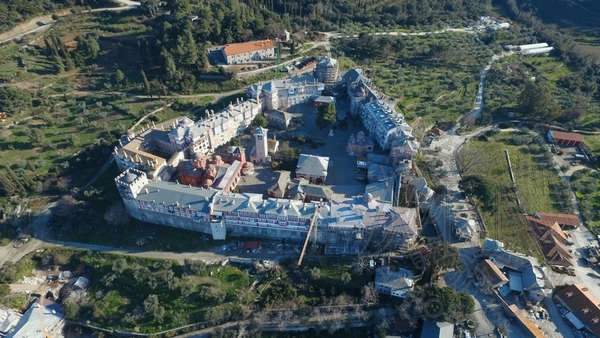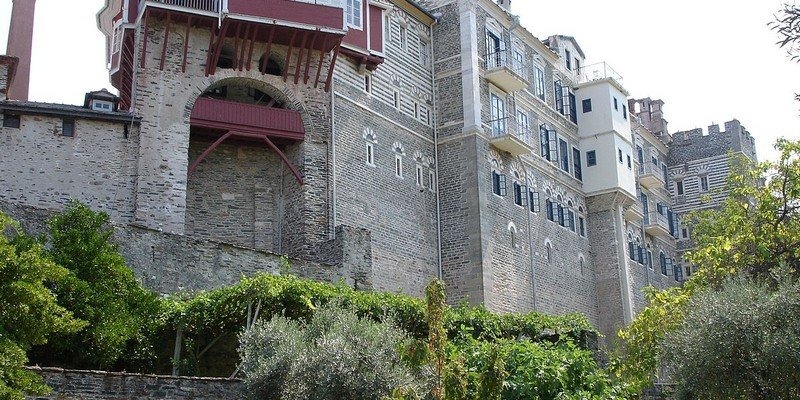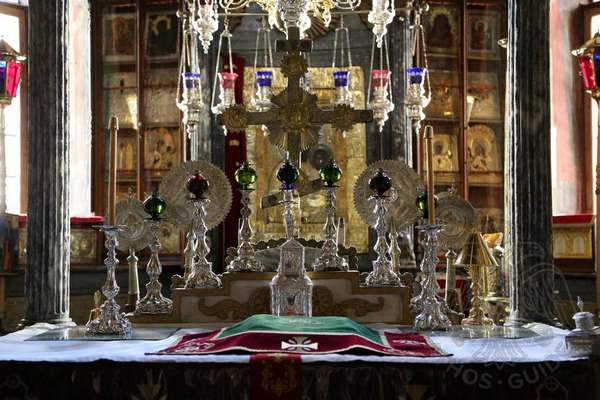History and present days
Byzantine Period

Taking the road to the Monastery of Vatopedi, one encounters the impressive aqueduct and the ruins of the Athonite Academy. At the center of the ruined building, which once housed 170 cells and rooms, there stands the recently renovated Church of Prophet Elijah. Further along, the road crosses in front of the built shed (1877) containing the monastery's well, where on the Feast of Epiphany a consecration ceremony and a procession of the holy icon of Theotokos Vematarissa take place. The road leads to the main entrance of the Monastery of Vatopedi.
Undoubtedly, the monastery’s view is far more imposing from the sea than from the mainland. The wide bay welcomes all visitors to the splendor of the athonite beauty. The monastery is positioned to the left, at an altitude of 20 meters. The architectural complexity, with multiple wings, domes and towers, creates a striking impression. The long northern wing, with its balconies, overlooks a multitude of auxiliary buildings, including the fishing houses, the structures of the arsanas and the workers lodges along the shore. Many travelers have described the appearance of the monastery as an autonomous settlement rather than a mere monastic community. This majestic panorama will soon be enhanced by the construction of a new church dedicated to Saint Gregory Palamas. Beyond the bay, there extends the large sandy beach of the Great Kalamitsi (Μεγάλο Καλαμίτσι), characterized by a rock with a cross known as "Hegoumen." This landmark commemorates the martyrdom of Abbot Euthymios, who, along with twelve other monks, was executed by the authorities in 1279/80. Their memory is annually honored on January 4th.
The monastery’s bay historically served as a safe harbor, with many pilgrims arriving directly from Constantinople and Kavala. An imperial chrysobull granted the monastery the privilege of owning large ships, a right maintained even during the Ottoman period. The two-story arsanas building, on the left side of the pier, is the oldest. The ground floor was constructed by Stefan Boevoda in 1496 and was renovated in 1672 by the abbot Dionysios. On its facade, a relief depicts Boevoda, with a sword and a helmet, offering a temple to the Virgin Mary. The eastern section, added in 1872, includes the chapel of Saint Nicholas. In this area there is also a vaulted fountain. Other structures within the arsanas include workers' residences, fish houses, a timber-drying facility, a carpenter’s shop and an oil press, most of which date to the late 19th century, when the arsanas supported the needs of the construction of the Skete of Saint Andrew (Serai) in Karyes.
In 1930, a 700-meter carpet was laid between the arsanas and the monastery to welcome the Prime Minister Eleftherios Venizelos. The carpet, woven in 1913 with the monastery’s monogram and two-headed eagles, was originally intended for King Constantine, who did not visit Mount Athos. It is interesting that in the end the carpet was used by his political adversary, which reflects the historical contradictions taking place in Athos. As an example we can refer to the commemoration of both the Emperor Nikephoros Phokas and his assassin, John Tzimiskes.
The monastic complex is remarkable both in scale and structure. Its wings form an irregular triangular shape, highlighting its fortified character. The north wing, extending 200 meters and dating to the mid-17th century, has suffered severe damage from fires but has recently been restored. The fortified enclosure includes nine towers, three of which retain their roofs. The architectural complex has also been through significant damage from fires in 1854 and 1882.
Vatopedi or Vatopaidi?
 The spelling "Vatopedi" is historically attested in the earliest documents, linking the name to the words “βάτο” (bush) and "πεδίο" (filed). In contrast, the alternative spelling "Vatopaidi" connects the name to the words “βάτο” (bush) and "παιδί" (child). According to this tradition, the son of the Emperor Theodosius the Great, Arcadius, was miraculously saved from a shipwreck and found unharmed beneath a bush on this coast. In gratitude, Theodosius is said to have founded a monastery on the ruins of a church originally built by Constantine the Great and later demolished by Julian the Apostate. However, due to lack of evidence supporting this tradition, many scholars favor the "Vatopedi" spelling. Nevertheless, recent excavations in the monastery’s courtyard have uncovered remnants of an early Christian church beneath the 10th-century katholikon, suggesting that the traditional athonite narration should be further investigated. The brotherhood of the monastery still prefers the "Vatopaidi" spelling.
The spelling "Vatopedi" is historically attested in the earliest documents, linking the name to the words “βάτο” (bush) and "πεδίο" (filed). In contrast, the alternative spelling "Vatopaidi" connects the name to the words “βάτο” (bush) and "παιδί" (child). According to this tradition, the son of the Emperor Theodosius the Great, Arcadius, was miraculously saved from a shipwreck and found unharmed beneath a bush on this coast. In gratitude, Theodosius is said to have founded a monastery on the ruins of a church originally built by Constantine the Great and later demolished by Julian the Apostate. However, due to lack of evidence supporting this tradition, many scholars favor the "Vatopedi" spelling. Nevertheless, recent excavations in the monastery’s courtyard have uncovered remnants of an early Christian church beneath the 10th-century katholikon, suggesting that the traditional athonite narration should be further investigated. The brotherhood of the monastery still prefers the "Vatopaidi" spelling.
History
The location of the present monastery was once home to the ancient city of Dion.
Tradition attributes the monastery’s founding to Constantine the Great, who built a church there in 321 AD, later destroyed by Julian the Apostate. Theodosius the Great is said to have rebuilt the church in gratitude for the miraculous rescue of his son Arcadius. However, historical records do not substantiate this claim or the tradition that Theodosius donated gold and silver vessels to the monastery. According to another narration, Theodosius’s daughter, Galla Placidia, attempted to enter the monastery but was stopped by the voice of the Virgin Mary. In response, she commissioned the construction of the Chapel of Saint Demetrios.
The earliest documented reference to the monastery appears in a 985 AD document signed by the abbot Nicholas. According to the "Life of Saint Athanasios the Athonite," three nobles from Adrianople, Athanasios, Nicholas and Anthony, came to Mount Athos in order to establish a monastery. Encouraged by Saint Athanasios, they chose to restore the Vatopedi Monastery, which had been destroyed by pirates. Since Vatopedi is absent from the First Typikon of Mount Athos (972), its reestablishment likely occurred between 972 and 985. Between 999 and 1002, it was involved in territorial disputes with the nearby Monastery of Philadelphos. By the decision of the Protos, the disputed territory was attributed to Vatopedi, confirming that the three founders had restored rather than originally established the monastery. By 1045, Vatopedi held the second hierarchical rank among the athonite communities. It flourished during the reign of the Emperor Andronikos II Palaiologos (1282–1328) and continued to expand, acquiring numerous dependencies and receiving significant support from Serbian rulers. Despite suffering from pirate attacks and political conflicts, the monastery persevered its position and still remains one of Mount Athos’s most prominent monastic institutions.
The Ottoman raids of the 14th century led to the devastation of many monastic communities, prompting numerous ascetics to seek refuge in the fortified Monastery of Vatopedi. In 1347, the Emperor John VI Kantakouzenos (r. 1347–1354) granted the Monastery of Psychosostria in Constantinople to the community of Vatopedi. He visited the place, donating manuscript codices and other precious documents to its library. Tradition holds that he became a monk under the name Joasaph. However, this claim is not based on any historical sources. Similarly, Andronikos Palaiologos (later known as monk Akakios) also retired to the monastery.
Maximos the Greek (d. 1556) described Vatopedi as a semi-cenobitic community. The earliest documented effort to convert the monastery into a completely cenobitic institution dates to 1449. The idiorrhythmic system was initially adopted in response to economic difficulties, allowing monks to sustain themselves independently. The office of the abbot was retained primarily for spiritual duties, while the diakos had taken over all the administrative responsibilities. In 1573, the monastery returned to the cenobitic system by a decree of the Patriarch Jeremiah II, due to the efforts of the Patriarch Silvester of Alexandria. However, in 1661, it reverted once again to its idiorrhythmic structure. A later attempt to reinstate the cenobitic system in 1820, was canceled after the outbreak of the Greek War of Independence. The monastery remained idiorrhythmic until 1989.
To cope with the ongoing threat of pirate raids, the monastery sought protection from Western rulers. King Alfonso of Aragon (1456), the Marquis William of Montferrat (1512) and Francis Morosini, Captain General of the Venetian Republic (1664), issued decrees placing Vatopedi under their protection. In 1439, Pope Eugene IV of Rome encouraged Roman Catholic pilgrims to visit the monastery and offer financial support.

During the 17th century, heavy taxation forced the monastery to sell many of its estates in order to sustain approximately 100 monks. Russian tsars and rulers of the Danubian Principalities provided financial support by donating land to the monastic community. By the 18th century, Vatopedi experienced a new age. The establishment and funding of the Athonite Academy (1748–1809) is a proof of this revival. In 1860, the monastery built a school in Pedoula, Cyprus, and in 1880, contributed to the construction of the Phanar Greek Orthodox College in Constantinople. Other notable contributions included financial support for the Theological School of Halki (1908), the School of Languages in Constantinople (1912) and the "Didactical School of Vatopedi" in Larnaca, Cyprus (1915). The monastery's relationship with Cyprus was further strengthened in 1987 with the arrival of the Elder Joseph of Vatopedi and his disciples from the New Skete. The first abbot of the restored cenobitic monastery (1990) was a disciple of the Elder Joseph, as were most of the resident monks, who were also coming from Cyprus.
Saint Gregory Palamas was a monk at Vatopedi. For three years he was under the guidance of Saint Nicodemos before moving to the Monastery of Great Lavra. Other significant figures linked to the monastery are Saint Joseph of Meteora, Saint Savvas of Vatopedi and Saint Theophanes, who was canonized in 2000. Additionally, Saint Gennadios, Saint Neophytos and Saint Makarios the Makris (d. 1431) played important roles in the monastery's spiritual and theological history. In 1456 Gennadios II Scholarios, the first Patriarch of Constantinople, visited the Monastery of Vatopedi, after the fall of the Byzantine Empire and before he retired to the Monastery of Saint John the Forerunner in Serres, where he passed away in 1460.


 In the southern part of the courtyard, there stands a fountain in the form of an ancient Greek tomb. Designed and constructed within the monastery by the Austrian architect Peter Müller and his associate, the fountain was supplied with water from the Skete of Saint Demetrios.
In the southern part of the courtyard, there stands a fountain in the form of an ancient Greek tomb. Designed and constructed within the monastery by the Austrian architect Peter Müller and his associate, the fountain was supplied with water from the Skete of Saint Demetrios. The frescoes were repainted in 1819. To the right stands the Chapel of Saint Nicholas. Above its lintel, there is a mosaic representation, one of the very few surviving Byzantine mosaics (11th century) in Mount Athos. Within the chapel, which was decorated by frescoes in 1780, a section of the older marble templon of the katholikon is also preserved. This earlier templon is lower than the current one and dates back to the Byzantine era. To the right, there is a fresco of the Virgin Mary holding the Holy Infant, located where the icon of
The frescoes were repainted in 1819. To the right stands the Chapel of Saint Nicholas. Above its lintel, there is a mosaic representation, one of the very few surviving Byzantine mosaics (11th century) in Mount Athos. Within the chapel, which was decorated by frescoes in 1780, a section of the older marble templon of the katholikon is also preserved. This earlier templon is lower than the current one and dates back to the Byzantine era. To the right, there is a fresco of the Virgin Mary holding the Holy Infant, located where the icon of  On the eastern columns of the main church, there is a mosaic representation of the Annunciation (11th century), similar to the one in the lity. It strongly reminds of the mosaics of Nea Moni on Chios. It appears that there were more additional mosaic compositions, that suffered serious damage and were replaced in 1312, during the reign of Andronikos II Palaiologos. The new frescoes, works of the Macedonian school of iconography, were largely repainted in 1739 and again in 1819. The second repainting was executed by the Galatian painters Benjamin and Zacharias. There are depicted scenes from the Divine Passion and the Resurrection, while their narrative depth and artistic quality are remarkable. They bear similarities with the frescoes of the Protaton, though their arrangement closely resembles that of the katholikon of the Monastery of Great Lavra. Christ the Almighty and the Prophets depicted in the dome, originally a work of the Macedonian School, were repainted in 1739.
On the eastern columns of the main church, there is a mosaic representation of the Annunciation (11th century), similar to the one in the lity. It strongly reminds of the mosaics of Nea Moni on Chios. It appears that there were more additional mosaic compositions, that suffered serious damage and were replaced in 1312, during the reign of Andronikos II Palaiologos. The new frescoes, works of the Macedonian school of iconography, were largely repainted in 1739 and again in 1819. The second repainting was executed by the Galatian painters Benjamin and Zacharias. There are depicted scenes from the Divine Passion and the Resurrection, while their narrative depth and artistic quality are remarkable. They bear similarities with the frescoes of the Protaton, though their arrangement closely resembles that of the katholikon of the Monastery of Great Lavra. Christ the Almighty and the Prophets depicted in the dome, originally a work of the Macedonian School, were repainted in 1739. The latter was renovated in 1846. According to tradition, as the abbot was about to hand the keys to the doorkeeper, in order to open the monastery gate, he heard Theotokos command that the gates should not be opened and that all monks should go to the walls to confront the pirates who had surrounded the monastery. The command was repeated. The abbot saw Jesus Christ attempting to close His mother’s mouth with His hand, saying: "Do not, Mother, look upon this sinful community. Allow it to perish by the sword of the pirates, for its sins have multiplied."
The latter was renovated in 1846. According to tradition, as the abbot was about to hand the keys to the doorkeeper, in order to open the monastery gate, he heard Theotokos command that the gates should not be opened and that all monks should go to the walls to confront the pirates who had surrounded the monastery. The command was repeated. The abbot saw Jesus Christ attempting to close His mother’s mouth with His hand, saying: "Do not, Mother, look upon this sinful community. Allow it to perish by the sword of the pirates, for its sins have multiplied."




